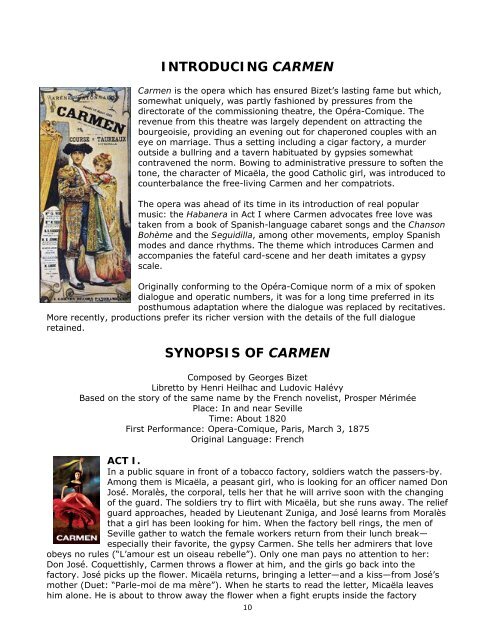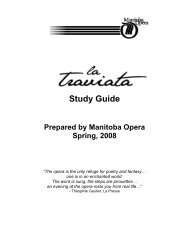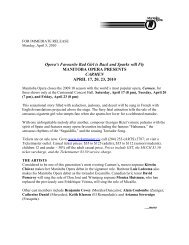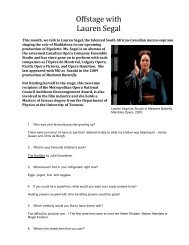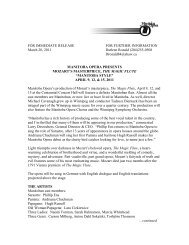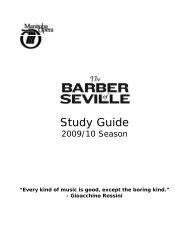Create successful ePaper yourself
Turn your PDF publications into a flip-book with our unique Google optimized e-Paper software.
INTRODUCING CARMEN<br />
<strong>Carmen</strong> is the opera which has ensured Bizet’s lasting fame but which,<br />
somewhat uniquely, was partly fashioned by pressures from the<br />
directorate of the commissioning theatre, the Opéra-Comique. The<br />
revenue from this theatre was largely dependent on attracting the<br />
bourgeoisie, providing an evening out for chaperoned couples with an<br />
eye on marriage. Thus a setting including a cigar factory, a murder<br />
outside a bullring and a tavern habituated by gypsies somewhat<br />
contravened the norm. Bowing to administrative pressure to soften the<br />
tone, the character of Micaëla, the good Catholic girl, was introduced to<br />
counterbalance the free-living <strong>Carmen</strong> and her compatriots.<br />
The opera was ahead of its time in its introduction of real popular<br />
music: the Habanera in Act I where <strong>Carmen</strong> advocates free love was<br />
taken from a book of Spanish-language cabaret songs and the Chanson<br />
Bohème and the Seguidilla, among other movements, employ Spanish<br />
modes and dance rhythms. The theme which introduces <strong>Carmen</strong> and<br />
accompanies the fateful card-scene and her death imitates a gypsy<br />
scale.<br />
Originally conforming to the Opéra-Comique norm of a mix of spoken<br />
dialogue and operatic numbers, it was for a long time preferred in its<br />
posthumous adaptation where the dialogue was replaced by recitatives.<br />
More recently, productions prefer its richer version with the details of the full dialogue<br />
retained.<br />
SYNOPSIS OF CARMEN<br />
Composed by Georges Bizet<br />
Libretto by Henri Heilhac and Ludovic Halévy<br />
Based on the story of the same name by the French novelist,<br />
Prosper Mérimée<br />
Place: In and near Seville<br />
Time: About 1820<br />
First Performance: <strong>Opera</strong>-Comique, Paris, March 3, 1875<br />
Original Language: French<br />
ACT I.<br />
In a public square in front of a tobacco factory, soldiers watch the passers-by.<br />
Among them is Micaëla, a peasant girl, who is looking for an officer named Don<br />
José. Moralès, the corporal, tells her that he will arrive soon with the changing<br />
of the guard. The soldiers try to flirt with Micaëla, but she runs away. The relief<br />
guard approaches, headed by Lieutenant Zuniga, and José learns from Moralès<br />
that a girl has been looking for him. When the factory bell rings, the men of<br />
Seville gather to watch the female workers return from their lunch break—<br />
especially their favorite, the gypsy <strong>Carmen</strong>. She tells her admirers that love<br />
obeys no rules (“L’amour est un oiseau rebelle”). Only one man pays no attention to her:<br />
Don José. Coquettishly, <strong>Carmen</strong> throws a flower at him, and the girls go back into the<br />
factory. José picks up the flower. Micaëla returns, bringing a letter—and a kiss—from José’s<br />
mother (Duet: “Parle-moi de ma mère”). When he starts to read the letter, Micaëla leaves<br />
him alone. He is about to throw away the flower when a fight erupts inside the factory<br />
10


